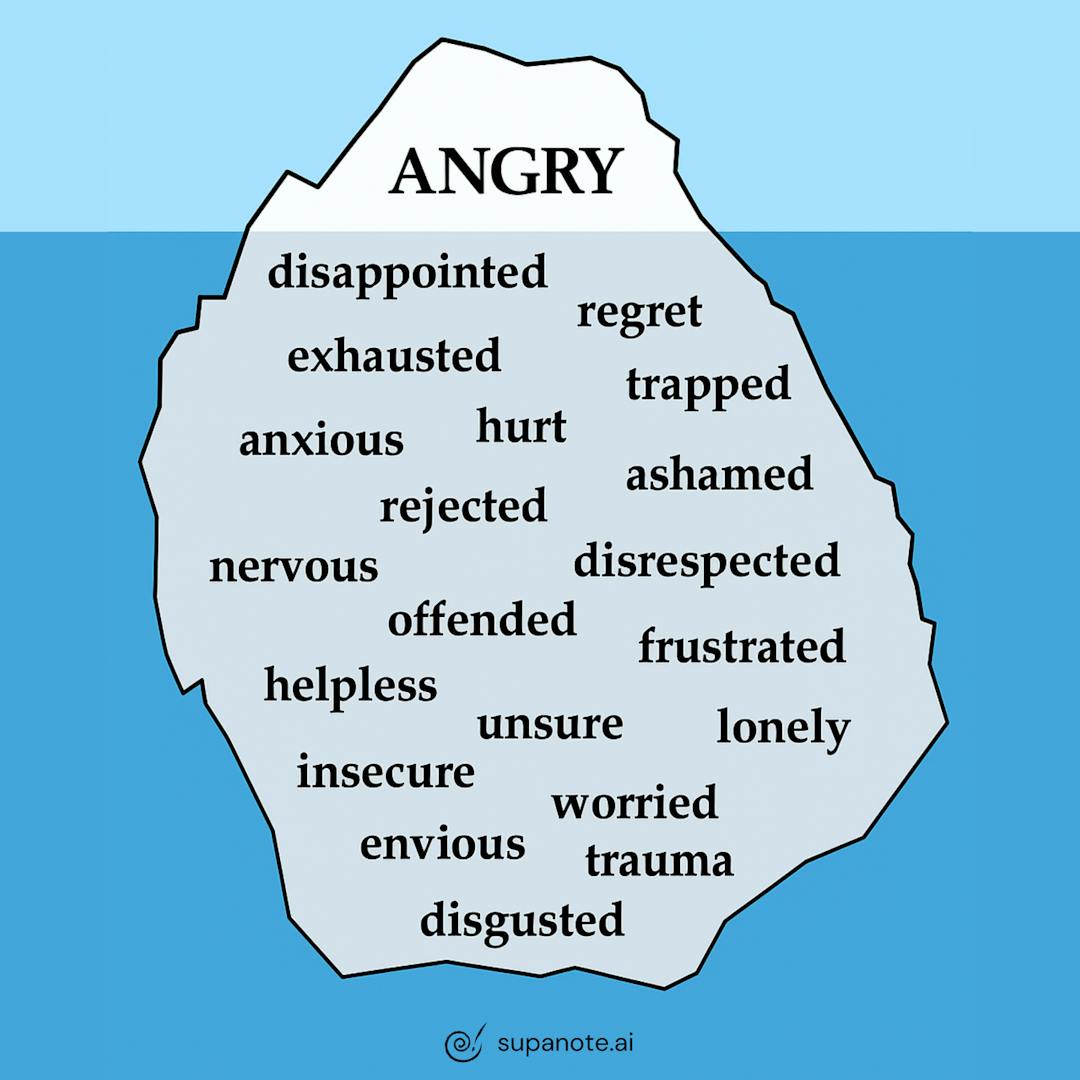Maria storms into session, arms crossed, jaw tight.
“My teenager is impossible,” she says. “I’m angry all the time now.”
Mental health professionals hear this often. When clients lead with anger, it’s rarely just about the surface emotion. It’s diagnostic.
The anger iceberg framework helps make sense of these moments. Anger is just the top layer. Beneath it are underlying emotions - often fear, grief, shame, or helplessness.
Instead of focusing on managing anger, this approach shifts the work toward uncovering what’s driving it. That shift transforms the therapeutic process and deepens the clinical impact.
What is the Anger Iceberg Theory?
Anger is often just the surface. Underneath, it hides vulnerable emotions like fear, hurt, shame, and powerlessness.
That’s the core idea behind the anger iceberg theory. It explains that anger is almost always a secondary emotion - a reaction that protects vulnerable emotions underneath.
Just think of a real iceberg. Only the tip appears above water. The remaining 90% stays hidden beneath the surface. The anger iceberg represents this exact dynamic with human emotions.
The Gottman Institute developed this framework through 50+ years of research. They discovered that anger consistently masks deeper feelings like fear, hurt, shame, and powerlessness.

How Understanding the Anger Iceberg Changes Everything?
Traditional anger management tends to focus on surface behavior - teaching clients to breathe, count, or communicate calmly. These skills are helpful in the moment but often miss the real cause of the anger.
And that’s the problem: anger isn’t just a behavior to fix - it’s protection.
When we try to control the anger without exploring what it's defending, we risk removing that protection without addressing the vulnerable emotions underneath.
Clients might feel better temporarily, but the underlying pain still exists - so the anger comes back.
And when it does, they blame themselves for “failing” at anger management.
That’s where the anger iceberg framework becomes a clinical game-changer.
It invites us to ask the most fundamental question: What is this anger trying to protect?
By shifting from control to curiosity, we reduce shame, increase emotional insight, and help clients reconnect with their core feelings.
That’s what leads to deeper healing- not just better behavior.
What Are the 4 Roots of Anger?
Research identifies four primary emotions consistently hiding beneath angry expressions.
1. Fear-Based Anger
Root emotion: Fear of loss, abandonment, or threat.
Clinical presentation: Sarah gets furious when her husband works late. She presents this as anger about "disrespect." Exploration reveals deep abandonment fears from childhood.
Common anger triggers:
- Relationship changes
- Job insecurity
- Health concerns
- Financial stress
Therapeutic approach: Address underlying fears while validating anger's protective function. Help clients communicate actual needs rather than just expressing anger.
2. Hurt-Based Anger
Root emotion: Emotional pain from rejection, criticism, or betrayal.
Clinical presentation: Marcus explodes at his teenage son for "talking back." Beneath the surface lies profound hurt that his son no longer values his opinion.
Common triggers:
- Criticism or feedback
- Feeling ignored
- Betrayal of trust
- Disappointment
Therapeutic approach: Create a safe space for vulnerability before addressing anger effectively. Feeling hurt requires validation and healing, not behavioral control.
3. Shame-Based Anger
Root emotion: Feelings of inadequacy or unworthiness.
Clinical presentation: Lisa has explosive outbursts at work during meetings. Investigation reveals her anger protects against shame about not being "smart enough."
Common triggers:
- Performance feedback
- Being questioned
- Making mistakes publicly
- Comparisons with others
Therapeutic approach: Gentle shame work alongside anger exploration. Shame thrives in secrecy, so creating non-judgmental therapeutic space is crucial.
4. Powerlessness-Based Anger
Root emotion: Helplessness or lack of control.
Clinical presentation: Simon lashes out at her child’s school and therapist, furious over delays in getting support. Underneath is deep helplessness - she feels like she’s failing her child despite doing everything she can.
Common triggers:
- System failures
- Chronic illness
- Caregiving responsibilities
- Financial constraints
Therapeutic approach: Focus on areas where clients do have agency. Help them distinguish between what they can and can’t control.
Why These Emotions Hide?
Several factors drive certain emotions underground:
Cultural messages: Many cultures teach that vulnerability equals weakness. Anger often feels more socially acceptable than sadness or fear.
Previous invalidation: Clients dismissed for expressing vulnerable emotions learn to lead with anger instead.
Protective instinct: Anger provides energy and power. Vulnerable emotions can make a person feel vulnerable and overwhelmed.
Limited vocabulary: Many lack feeling words for complex experiences beyond "angry" or "stressed."
The Anger Icebreaker: 5 Steps to Access Hidden Emotions
This therapeutic process helps clients access deeper emotions beneath angry presentations.
Step 1: Validate the Anger
Start here. Always.
"Your anger makes complete sense.", "Anger gives us important information.", "Let's explore what your anger protects."
Never skip this step. Invalidated clients shut down immediately.
Step 2: Explore Physical Sensations
"Where do you feel this anger in your body?",
"What physical sensations come with feeling angry?",
"If you breathe into that area, what else do you notice?"
These questions ground clients in their bodily experience, helping shift them from reactive mode into reflective mode.
By tuning into physical sensations, clients begin to slow down their emotional responses and access deeper awareness.
Most clients discover that anger shows up with specific physical signatures like tight jaw, clenched fists, heat in the chest - things they would have never noticed before.
This body-based awareness then becomes a bridge to recognizing the emotions underneath.
Step 3: Map the Timeline
"What happened right before you felt angry?", "Walk me through the sequence.", "What was the very first feeling you noticed?"
This identifies primary emotions that anger stepped in to protect. Often there's a split second of vulnerability before anger takes over.
Step 4: The Vulnerability Question
“If the anger stepped aside for a second… what feeling do you think might show up underneath?”
“What do you think the anger’s been trying to shield you from feeling?”
“Can you remember the first time you felt something like this? What did you need back then that maybe you didn’t get?”
“If you didn’t have to stay in ‘angry mode,’ what feeling would be hardest to sit with?”
“When this kind of feeling came up when you were younger, how did you usually deal with it - or how did people around you respond?”
Use this only after establishing trust and validation.
Step 5: Integration
“It makes sense that anger showed up - it’s been doing a lot of heavy lifting for you. What do you think it’s been trying to protect?”
This normalization reduces shame and creates space for emotional responses to coexist.
Case Example
Last month, I worked with David, angry about his daughter's grades. Using this process, we discovered his anger protected fear about her future—stemming from his own academic struggles.
Once we identified this fear, he could communicate actual concern instead of criticizing. The whole family dynamic shifted toward healthier relationships.
Applying the Anger Iceberg in Mental Health Treatment
Assessment Strategies
Intake considerations:
- Family emotional rules about anger and vulnerability
- Cultural influences on emotional expression
- Previous therapy experiences
- Trauma history and safety concerns
Real-time observation:
- Body language shifts during anger discussions
- Voice changes when exploring emotions
- Facial expressions revealing vulnerability
- Language patterns describing triggers
How to Use the Anger Iceberg in Different Modalities
Cognitive Behavioral Therapy (CBT):
- Thought records including underlying emotions
- Behavioral experiments testing anger's protective function
- Cognitive restructuring of vulnerability beliefs
Dialectical Behavior Therapy (DBT):
- Emotion regulation skills for primary emotions
- Distress tolerance for difficult emotions
- Interpersonal effectiveness for expressing needs
General therapeutic approaches:
- Creating safe space for emotional exploration
- Validating both anger and underlying feelings
- Teaching emotional intelligence skills
- Improving communication skills for expressing full range of emotions
Documentation for Mental Health Practice
Progress notes: "Client identified hurt feelings underlying anger toward spouse."
"Explored protective function of anger in response to criticism."
"Demonstrated increased emotional awareness in trigger situations."
Treatment planning: Focus on emotional regulation, better understanding of triggers, and developing healthy ways to express underlying feelings.
Practical Tools and Interventions
Assessment Tools
- Anger iceberg worksheet: Helps clients map their emotional experiences and identify patterns.
- Emotion wheels: Expand feeling words vocabulary beyond basic angry/sad/happy.
- Daily emotion logs: Track anger triggers and underlying emotions over time.
Intervention Strategies
Regulation techniques:
- Deep breaths for nervous system calming
- Progressive muscle relaxation
- Grounding exercises for present-moment awareness
Emotional awareness building:
- Mindfulness for recognizing emotional responses
- Journaling for processing difficult emotions
- Role-playing for practicing vulnerability
Communication skills training:
- Scripts for expressing underlying needs
- Assertiveness training for healthy boundaries
- Conflict resolution focusing on deeper feelings
Online Therapy and In Person Therapy Applications
The anger iceberg helps in both online therapy and in person therapy settings:
Virtual adaptations:
- Screen sharing anger iceberg visuals
- Digital emotion tracking tools
- Teletherapy-appropriate regulation techniques
In-person benefits:
- Full body language observation
- Immediate physical comfort when needed
- Experiential techniques like chair work
Cultural and Clinical Considerations
Special Populations
- Men's therapy: Address cultural barriers to vulnerability. Reframe emotional exploration as emotional intelligence development.
- Adolescents: Involve family members in emotional education. Connect awareness to personal growth and future relationship success.
- Trauma survivors: Move slowly and prioritize safety. Anger often protects against re-experiencing trauma.
Cultural Sensitivity
Different cultures have varying rules about emotional expression:
- Some view anger as strength, others as disruption
- Gender-specific emotional rules vary significantly
- Religious frameworks may affect emotional interpretation
Work collaboratively to adapt the anger iceberg metaphor to fit each person's cultural worldview.
Case Study: Comprehensive Application
Presentation
Sarah, 34, sought therapy for workplace anger management issues. She reported explosive outbursts during team meetings when receiving feedback.
Assessment
- Surface presentation: Outbursts during perceived criticism
- Physical warning signs: Jaw tension, rapid heartbeat
- Trigger pattern: Being questioned publicly
- Underlying discovery: Shame about intellectual adequacy
Treatment Process
Using the anger iceberg framework:
- Validated her workplace anger as protective
- Explored physical sensations of chest tightness
- Mapped timeline from question to anger explosion
- Discovered underlying shame and fear of being "found out"
- Integrated understanding of anger as protection against vulnerability
Interventions
- Shame resilience work
- Communication skills for expressing uncertainty
- Somatic regulation techniques
- Professional development planning
Outcomes
After 16 sessions:
- 70% reduction in workplace anger episodes
- Improved professional relationships
- Enhanced emotional intelligence
- Successful promotion
- Better understanding of emotional well being
Helpful Tips for Therapists
Managing Your Own Emotions
Working with anger requires managing our emotional responses:
- Notice your anger triggers in sessions
- Understand what vulnerable emotions your anger protects
- Seek professional support when needed
- Maintain boundaries for emotional well being
Creating Safety
Essential elements:
- Validate anger before exploring underneath
- Move at client's pace
- Respect defenses and resistance
- Model healthy emotional expression
Some Common Pitfalls
- Rushing to vulnerability too quickly
- Assuming specific emotions
- Trying to eliminate anger instead of understanding it
- Missing cultural factors affecting expression
Streamlining Your Anger Iceberg Documentation
Anger iceberg sessions generate incredibly rich clinical material. You're tracking emotional breakthroughs, noting protective patterns, documenting underlying discoveries. It's valuable work that requires thorough documentation.
Here's where AI therapy tools like Supanote become game-changers. Supanote automatically generates HIPAA-compliant notes in whatever format you prefer- SOAP notes, DAP notes, BIRP notes, or GIRP notes. It captures the emotional progression from initial anger presentations to those breakthrough moments when clients access vulnerability.
Instead of spending 20 minutes after each session writing detailed notes, you focus entirely on the therapeutic work. Supanote handles the documentation.
Your notes accurately reflect both the protective function of anger and the underlying emotions discovered, supporting treatment planning and insurance requirements.
Try Supanote for Free Today!
Automated, HIPAA-compliant Progress Notes so you can focus on your clients
Get Started Now!
Resources and Tools
Client Resources
Worksheets:
Self-help strategies:
- Mindfulness practices for emotional awareness
- Journaling prompts for exploring feelings
- Regulation techniques for managing impulsive outbursts
Professional Development
Training opportunities:
- Gottman Method couples therapy
- Emotion-focused therapy certification
- Cultural competency training
- Trauma-informed care
Frequently Asked Questions
Q: What exactly is the anger iceberg theory?
A: The anger iceberg theory explains anger as a secondary emotion protecting vulnerable primary emotions underneath. Like an iceberg, only 10% (anger) is visible while 90% (fear, hurt, shame, powerlessness) remains hidden beneath the surface.
Q: What are the 4 main roots of anger?
The four primary roots are:
- Fear-based anger (protecting against threats),
- Hurt-based anger (protecting against emotional pain),
- Shame-based anger (protecting against inadequacy feelings)
- Powerlessness-based anger (protecting against helplessness).
Q: How does the anger iceberg help with mental health treatment?
A: It reframes anger from a behavior problem to diagnostic information, helps target root causes, reduces client shame, and leads to more effective treatment across various mental health conditions.
Q: Can this approach work for anger management issues?
A: Yes, it's particularly effective because it addresses underlying causes rather than just surface behaviors, leading to more sustainable change and better emotional well being.
Q: How do I know if I've identified the right underlying emotion?
A: Look for physical shifts (relaxed shoulders, deeper breathing), emotional resonance ("that feels right"), and vulnerability that feels more authentic than the presenting anger.
Q: What if my client resists exploring beneath their anger?
A: Always validate anger first, move slowly, respect defenses, and sometimes work with anger directly before exploring underneath. Resistance often indicates the client doesn't feel safe yet.
Q: How long does this work typically take?
A: Varies by client. Some connect immediately, others need weeks of trust-building. Don't rush—safety and therapeutic relationship are prerequisites for vulnerability exploration.
Q: Can I use this without specialized training?
A: Yes, the anger iceberg is a universal framework that integrates with most therapeutic approaches. Start with basic exploration and seek additional training for advanced applications.
Conclusion
The anger iceberg framework has revolutionized how I approach clients presenting with anger.
Instead of seeing anger as the problem, I view it as valuable information pointing toward deeper emotional needs.
This approach improves clinical outcomes and strengthens therapeutic relationships. Clients feel less shame when we honor anger's protective function while exploring underlying feelings.
When we help clients understand emotions beneath anger, we facilitate emotional growth, improve relationships, and address root causes for lasting change. This leads to better emotional well being and more fulfilling life experiences.
The framework works because it respects human emotional wisdom.
Anger develops for good reasons and protects us when we don't feel safe being vulnerable. Our job isn't eliminating this protection but creating enough safety for clients to risk showing their deeper feelings.
For mental health professionals, this provides a structured framework that integrates across therapeutic approaches. Whether using CBT, DBT, or other methods, the anger iceberg offers a roadmap for more effective work.
Start small. Try the five-step process with one client this week. Notice what changes when you approach anger with curiosity rather than management. The results might surprise you.
Ready to Try? 10 notes on us!
Login to your Supanote account and instantly access 10 free notes
Get Started Now!
